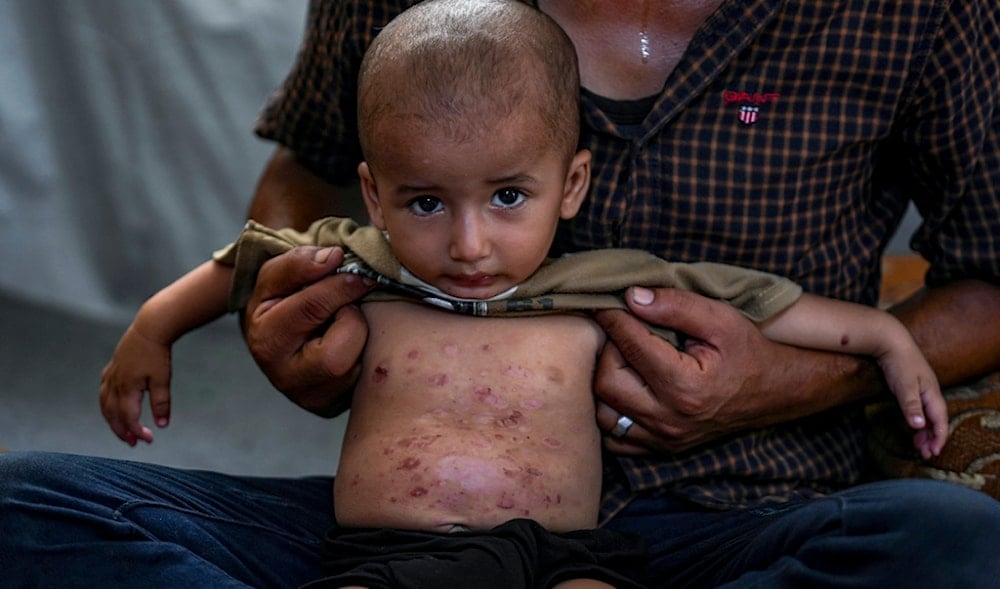Gaza Strip faces worsening health crisis as waste piles threaten lives
Palestinians in Gaza face severe health risks due to accumulating waste and sewage, worsened by the Israeli occupation's blockade and war, while UN agencies warn of a growing humanitarian disaster.
-

Displaced child Mohammed Abu Obaid, who suffers from skin disease, at a makeshift tent camp in Deir al-Balah, central Gaza Strip, Monday, July 29, 2024 (AP)
Displaced Palestinians in the Mawasi area of Khan Younis, southern Gaza Strip, are facing deteriorating health conditions due to the mounting accumulation of waste and garbage, according to the Palestinian Information Centre.
Among them is Um Yasser Dawoud, an asthma patient living in a tent. Her condition has worsened because of the constant foul smell of waste and sewage carried by the wind. “This place has become a source of diseases,” she said. “Stray dogs gather at night and bark loudly, terrifying the children. Mosquitoes and flies never leave our tents.”
The situation is exacerbated by the disposal of animal carcasses in the waste heaps, as the ongoing Israeli bombardment and the difficult living conditions prevent proper burial. “This increases the foul odours and spreads diseases because of the worms coming out of them and the insects infesting the area,” she added.
Health impacts deepen for Gaza’s displaced
In central Gaza City, Mohammed Abu Dan, who lives in al-Saha district, described how informal waste sites have led to his infant daughter suffering from skin irritations due to constant bites from mosquitoes and flies.
“My daughter’s body is covered in tiny blisters, and her skin is irritated because of the insects that never leave my house,” he said. Lacking pesticides or fumigation tools, his attempts to deal with the infestation have been unsuccessful.
He lives in a damaged ground-floor apartment close to a newly formed waste dump, created by residents as the Gaza Municipality cannot transport garbage to proper facilities.
UNRWA, municipalities warn of looming environmental disaster
Meanwhile, Sam Rose, Director of Planning at UNRWA, emphasized the gravity of the situation, stressing, “People are literally living amid waste. Mass displacement has burdened everyone.” The agency previously warned that the build-up of waste in the Gaza Strip presents a serious threat to health, as many people are living in tents surrounded by garbage. The worsening waste crisis, it noted, adds to the already severe environmental and health challenges.
The Union of Gaza Strip Municipalities also sounded the alarm over the escalating humanitarian disaster due to the occupation's relentless war. The union stated that municipalities are unable to function properly because of equipment shortages and widespread destruction of infrastructure, which has crippled essential services.
It called for immediate international assistance to provide municipalities with critical resources, including heavy machinery to manage the estimated 55 million tons of rubble scattered across Gaza’s governorates.
The Gaza Municipality has issued urgent warnings about an unprecedented health and environmental catastrophe. Over 175,000 tons of uncollected solid waste are clogging the streets, while occupation forces block access to the main Juhr al-Dik waste dump.
Municipal spokesperson Hosni Mehanna stated that efforts to mitigate the crisis with the help of international organisations are being obstructed by "Israel’s" refusal to permit new equipment or allow municipal teams to reach the main dump site. He warned of disease outbreaks from uncollected waste, sewage leaks, and decomposing bodies under the rubble of homes and civilian infrastructure.
Urgent need for sustainable waste solutions
The UN Development Programme (UNDP) has also described Gaza’s solid waste crisis as an emergency, calling for swift action. Before the war erupted in October 2023, the UNDP had proposed a long-term plan for sustainable waste management aimed at transitioning to a circular economy. However, war has shifted priorities to immediate humanitarian needs.
The number of waste collection vehicles in Gaza dropped from 112 to 73 between 2017 and 2022. Many of the remaining vehicles are outdated, with each now serving about 21,000 residents, and each sanitation worker responsible for over 3,000 people.
Environmental expert Dr. Nizar al-Wahidi estimates that each person in Gaza generates approximately half a kilogram of waste daily, requiring the disposal of about 1.2 million kilograms of solid waste every day. He warned that makeshift dumps near tents and homes are triggering severe skin and respiratory illnesses, while also fostering the spread of rodents, snakes, and disease-carrying insects. Decomposing waste releases toxic gases and dangerous odors.
“Fifty million cubic meters of sewage per day cannot reach treatment plants because the [Israeli occupation] has destroyed the infrastructure,” he pointed out. Streets are now flooded with sewage, turning into hazardous swamps. He also revealed that "Israel" had cut the only power line to the Deir al-Balah water treatment facility.
Al-Wahidi voiced serious concern about the mixing of organic waste with debris and metals from destroyed homes, which may include hazardous chemicals. If leachate from these dumps contaminates groundwater, untreated drinking water could become lethal. He urged the safe and proper burial of waste per international standards.

 5 Min Read
5 Min Read








